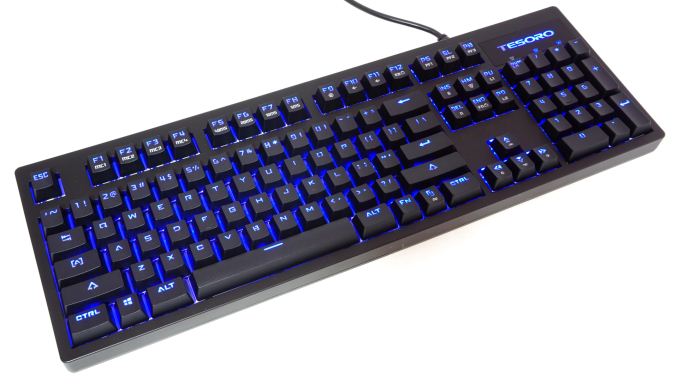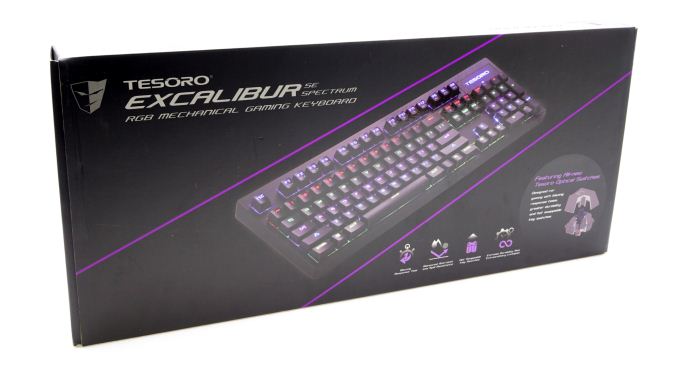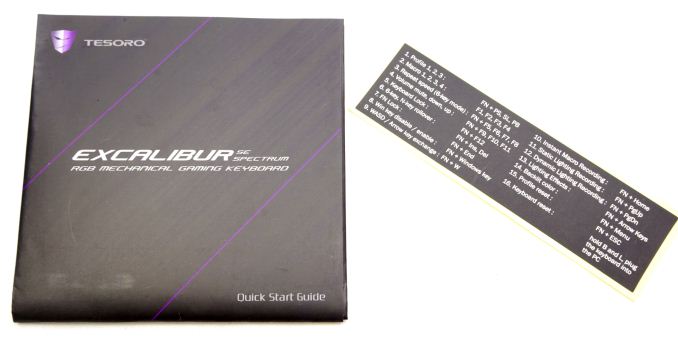The Tesoro Excalibur SE Spectrum Review: A Mechanical Keyboard with Gateron Optical Switches
by E. Fylladitakis on March 20, 2017 9:00 AM EST
The popularity of mechanical keyboards has led to the flooding of the market with hundreds of products, many of which had very small (or even zero) differences from each other. After all, there were only a handful of different keyboard switch types (and their clones), and there is only so much one can do with differentiating in terms of aesthetics and design without moving into software. This lack of variety, in conjunction with the very high popularity that mechanical keyboards have amongst gamers, has pushed the manufacturers to design and develop new, unique mechanical keyboard switches - often aimed directly towards gamers.
During the past couple of years, we have seen (and tested) several new switch designs that were trying to differentiate from the typical Cherry MX switches and their clones. Manufacturers experimented with the travel and actuation distance of the keys, or the differences were purely cosmetic, such as clear plastic bodies for better LED lighting effects.
In this review we are having a look at the new Tesoro Excalibur SE Spectrum, a keyboard with switches that are more than just a little different. The Excalibur SE Spectrum externally looks like a typical mechanical keyboard but its switches are optical, relying on infrared sensors rather than metallic contacts for signaling.
Packaging and bundle
Tesoro supplies the Excalibur SE Spectrum in a typical cardboard box with minimal, straightforward artwork. The design of the packaging is focused on the promotion of the optical key switches. It is a sturdy packaging that should be offering more than adequate protection to the keyboard during shipping.
Inside the packaging we only found a very basic manual and a small sticker listing the keyboard’s advanced keystroke functions. There is no keycap puller or other accessories supplied alongside with the Excalibur SE Spectrum.












21 Comments
View All Comments
MobiusPizza - Monday, March 20, 2017 - link
Currently, the only advantage over mechanical contacts apart from shorter travel. What they should aim for is programmable characteristics such as what travel distance activates the switch, as the sensor is capable of measuring the analogue movement.WorldWithoutMadness - Monday, March 20, 2017 - link
This one won't chatter like the traditional one.Kutark - Thursday, April 6, 2017 - link
So is it significantly quieter than a mechanical? I have a friend who continues to buy these horrifically bad Chiclet type keyboards because they have a very low actuation distance and are relatively quiet. He bitches constantly about how loud my keyboard is, so I can't even get him to try one out because of that.This sounds like it might be a good alternative option?
Old_Fogie_Late_Bloomer - Monday, March 20, 2017 - link
The advantage is that you don't need to wait for the switches to settle before decoding a keystroke, which in theory should lower latency. I dunno if that will really benefit anyone but competitive Korean StarCraft players, but that's the point of them.I use a Code Green primarily for my personal computing, where as long as I don't get strokes registering twice I'm happy and don't care about the slightly longer latency. But I'd definitely be interested in a red-equivalent optical switch for gaming (I have a Gateron Brown board for this but haven't had a lot of time to play lately).
Personally, I don't know why anyone markets blue switches to gamers, but obviously people are buying them. I find the mechanics of MX Greens to be an impediment for twitchy play, myself.
KAlmquist - Monday, March 20, 2017 - link
Why is it necessary to “wait for the switches to settle before decoding a keystroke?” When a mechanical switch closes, the contacts can bounce, causing the switch to open and close several times. So, the first time a switch closes, the keyboard reports the closing of the switch as a keystroke. The keyboard logic then has to identify the subsequent openings and closings as caused by contact bounce, which it does based on time. So the debouncing logic in the keyboard shouldn't introduce latency unless you manage to type quickly enough to confuse the debouncing logic. In particular, if you press a key and then release it really fast, the switch open caused by releasing the key could be confused with a contact bounce, causing the keyboard circuitry to delay reporting the key release until a timeout causes it to realize that it's not observing a contact bounce after all. But that's a delay in reporting a key release, not a key press, and I doubt that it happens in practice.sor - Tuesday, March 21, 2017 - link
A required delay in a key release is also a delay in the next key press. Probably not really any issue in practice, however, unless you like to type the same character at a rate of 100/second or more.sor - Tuesday, March 21, 2017 - link
For both keyboards it's required that the key travel backward 2mm to register a release, that's probably the limiting factor and introduces more than enough time to register debounce.SodaAnt - Monday, March 20, 2017 - link
How is the PWM on the RGB LEDs? I've seen a few keyboards where you get the rainbow effect if you move your vision on the keyboard too quickly, and the colors all end up splitting because the refresh rate is so low.pjcamp - Monday, March 20, 2017 - link
"The concept of making it plug & play, allowing the user to program lighting modes and macros without relying on software, is interesting..."I need to correct your typo here. It is not an interesting feature, it is REQUIRED in order to fully function with operating systems other than Windows. The folks down at Anandtech should recognize the existence of people who use Linux and Macs. When I bought my last keyboard, I spent a long time pouring over technical docs specifically to find one that was independent of Windows.
twtech - Monday, March 20, 2017 - link
And yet still, there is no MS Natural type split keyboard equivalent with mechanical keys. Considering the MS Natural shape & style remains the keyboard style of choice for many programmers and others that type all day, it seems like this should have been an obvious market to target.There are a few ergonomic mechanical keyboards, but most of them have nonstandard key layouts. There's the Matias Ergo Pro, which has a mostly-standard layout - and is what I'm using now - but it has some quirks with stuck keys, etc., comes in two separate halves connected by a wire, and is very thick (when tented it sits up over 2" off the desk in the center).
With all these generic mechanical keyboards coming out that are mostly all the same, you'd think someone would want to capitalize on the not-so-niche market of people who type all day and are willing to shell out the $150+ that many of these mechanical keyboards cost, but who also must have a split-style keyboard.